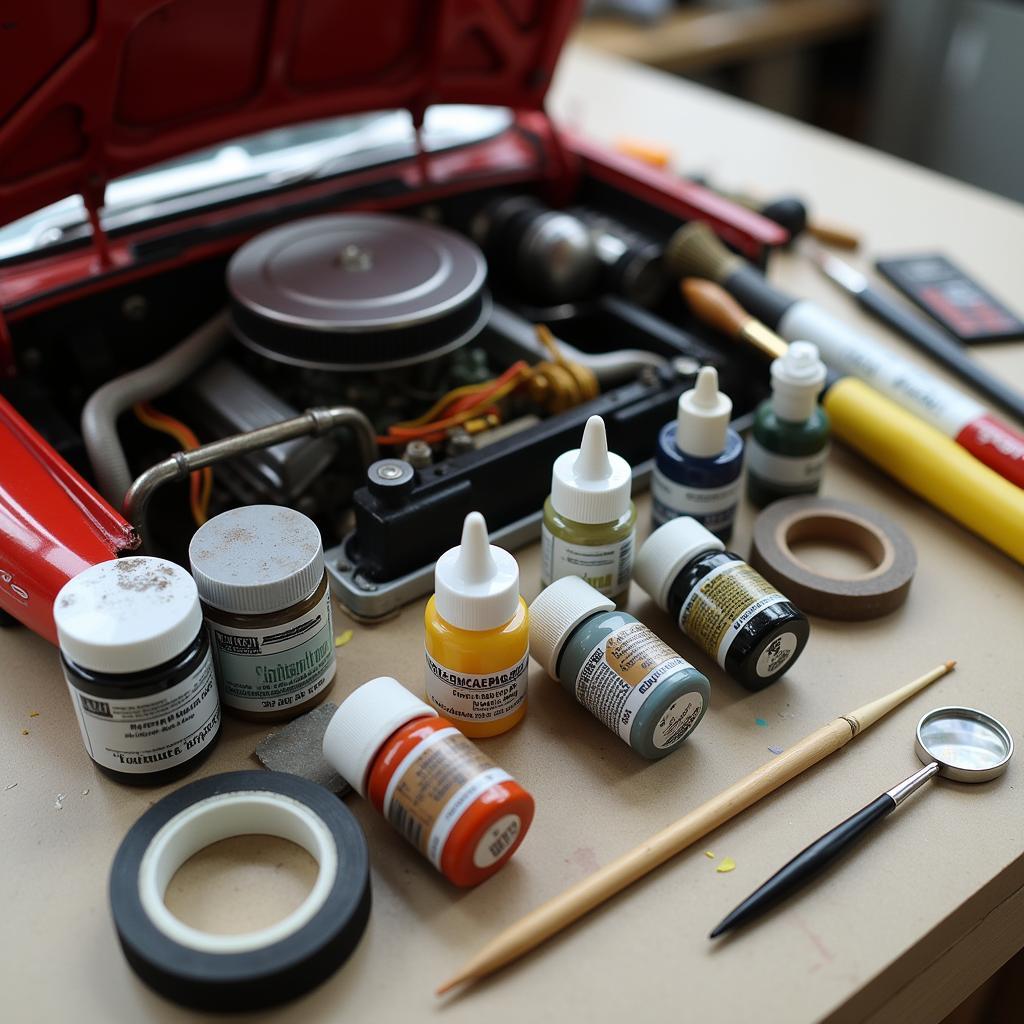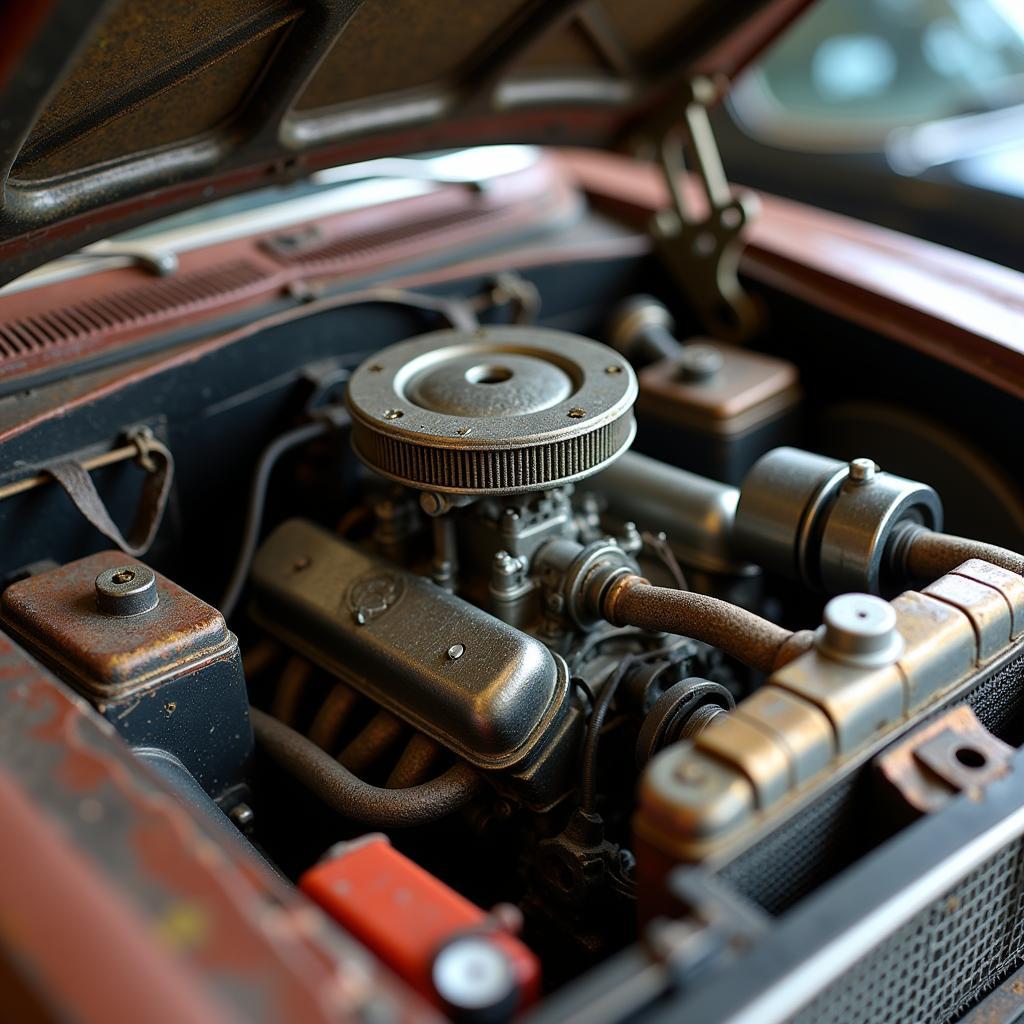Detailing Model Car Engines is a rewarding process that transforms a simple model into a realistic masterpiece. It’s more than just cleaning; it’s about enhancing the details and bringing the engine to life. Whether you’re a seasoned model car enthusiast or just beginning, this guide will equip you with the knowledge and techniques needed to achieve stunning results.
Why Detail Your Model Car Engine?
Adding detail to a model car engine drastically improves its realism. It’s the difference between a toy and a miniature work of art. A well-detailed engine becomes a focal point, drawing the eye and showcasing your attention to detail. It elevates the overall presentation of your model, making it stand out from the crowd. Plus, the process itself can be incredibly enjoyable, providing a relaxing and creative outlet.
Tools and Materials You’ll Need
Before diving in, gather the necessary tools and materials. Having everything prepared will make the detailing process smoother and more efficient. You will need:
- Fine paint brushes: For applying washes and dry brushing.
- Acrylic paints: In various colors to match the engine components.
- Enamel washes: To create depth and shadow.
- Weathering powders: For adding realistic grime and dirt.
- Cotton swabs: For cleaning up excess paint and applying washes.
- Masking tape: To protect areas you don’t want to paint.
- Toothpicks: For applying small amounts of paint and cleaning hard-to-reach areas.
- A magnifying glass: To aid in seeing fine details.
 Essential Tools for Detailing Model Car Engines
Essential Tools for Detailing Model Car Engines
Preparing the Engine for Detailing
Proper preparation is crucial for a successful detailing job. Start by carefully removing the engine from the model car body, taking care not to break any delicate parts. Clean the engine thoroughly with a mild soap and water solution to remove any dust or debris. Ensure the engine is completely dry before proceeding to the next step.
Painting and Detailing Techniques
The key to realistic detailing lies in using various painting techniques. Dry brushing is excellent for highlighting raised details, adding a touch of metallic sheen to edges and creating a worn look. Washes are perfect for adding depth and shadow to recessed areas, mimicking the grime and oil buildup found in real engines. Layering these techniques will create a more convincing and three-dimensional appearance.
Adding Realistic Touches
To take your detailing to the next level, consider adding realistic touches. Weathering powders can simulate rust, dirt, and grime, giving the engine a lived-in appearance. Adding small details like wires, hoses, and decals can further enhance the realism. Don’t be afraid to experiment and try different techniques to achieve the desired effect.
How to Weather a Model Car Engine
Weathering is the process of adding realistic wear and tear to your model. This can be achieved through various methods, such as dry brushing with lighter shades of paint to simulate chipped paint, applying washes to create grime and dirt build-up, and using weathering powders to simulate rust and other effects.
Sealing Your Work
Once you’re satisfied with the detailing, it’s important to seal your work. A clear coat sealant will protect the paint and detailing from damage and ensure that your hard work lasts. Choose a sealant that is compatible with the paints and materials you’ve used.
Showcasing Your Detailed Engine
After all the hard work, it’s time to showcase your masterpiece. Whether you’re displaying the model in a case or incorporating it into a diorama, a detailed engine is sure to impress. Take pride in your work and enjoy the satisfaction of transforming a simple model into a stunning replica.
 A Beautifully Detailed Model Car Engine
A Beautifully Detailed Model Car Engine
Conclusion
Detailing model car engines is a rewarding hobby that combines artistic skill with technical precision. By following these steps and practicing these techniques, you can transform your model cars from simple toys into realistic showpieces. So grab your tools and dive into the fascinating world of model car engine detailing!
FAQ
-
What type of paint is best for detailing model car engines?
Acrylic paints are generally preferred due to their ease of use and quick drying time. -
What is the purpose of using washes in detailing?
Washes add depth and shadow to recessed areas, creating a more realistic appearance. -
How can I prevent the paint from chipping off the engine?
Applying a clear coat sealant after painting will help protect the paint and detailing. -
Where can I find decals for my model car engine?
Hobby shops and online retailers offer a wide variety of decals for model cars. -
What is dry brushing, and how is it used in detailing?
Dry brushing is a technique used to highlight raised details by applying a small amount of paint to a dry brush. -
Can I use weathering powders on plastic model engines?
Yes, weathering powders are suitable for use on plastic model engines. -
What are some common mistakes to avoid when detailing model car engines?
Using too much paint or wash, not preparing the surface properly, and not sealing the finished product are some common mistakes to avoid.
Common Situations and Questions
Situation: You’re building a vintage muscle car model and want the engine to look authentically aged.
Question: What weathering techniques should I use to create a realistic vintage engine look?
Situation: You’re working on a model of a modern sports car and want the engine bay to appear pristine.
Question: What detailing techniques can I use to achieve a clean and polished look?
Situation: You accidentally applied too much wash to the engine.
Question: How can I remove the excess wash without damaging the paint?
Further Reading and Related Topics
Explore our website for more articles on model car building and detailing techniques, including:
- Painting and Weathering Techniques for Model Cars
- Advanced Detailing Tips for Model Car Engines
- Building Dioramas for Your Model Cars
Need further assistance? Contact us via WhatsApp: +1(641)206-8880, or Email: [email protected]. Our 24/7 customer support team is ready to help.

Leave a Reply